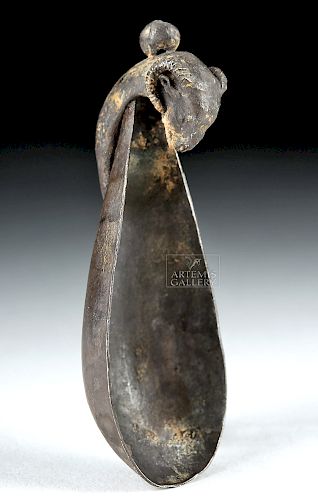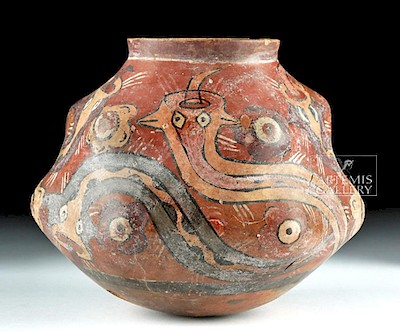Achaemenid Silver Ram-Headed Spoon - 9.7 grams
Lot 86
About Seller
Artemis Gallery
686 S Taylor Ave, Ste 106
Louisville, CO 80027
United States
Selling antiquities, ancient and ethnographic art online since 1993, Artemis Gallery specializes in Classical Antiquities (Egyptian, Greek, Roman, Near Eastern), Asian, Pre-Columbian, African / Tribal / Oceanographic art. Our extensive inventory includes pottery, stone, metal, wood, glass and textil...Read more
Categories
Estimate:
$2,200 - $3,300
Absentee vs Live bid
Two ways to bid:
- Leave a max absentee bid and the platform will bid on your behalf up to your maximum bid during the live auction.
- Bid live during the auction and your bids will be submitted real-time to the auctioneer.
Bid Increments
| Price | Bid Increment |
|---|---|
| $0 | $25 |
| $300 | $50 |
| $1,000 | $100 |
| $2,000 | $250 |
| $5,000 | $500 |
| $10,000 | $1,000 |
| $20,000 | $2,500 |
| $50,000 | $5,000 |
| $100,000 | $10,000 |
| $200,000 | $20,000 |
About Auction
By Artemis Gallery
Jul 5, 2018
Set Reminder
2018-07-05 10:00:00
2018-07-05 10:00:00
America/New_York
Bidsquare
Bidsquare : Ancient | Ethnographic | Fine Art
https://www.bidsquare.com/auctions/artemis-gallery/ancient-ethnographic-fine-art-3306
Featuring classical antiquities, ancient and ethnographic art from cultures encompassing the globe. Artemis Gallery info@artemisgallery.com
Featuring classical antiquities, ancient and ethnographic art from cultures encompassing the globe. Artemis Gallery info@artemisgallery.com
- Lot Description
Ancient Near East, Achaemenid Persian Empire, ca. 500 to 330 BCE. A beautifully delicate silver spoon, teardrop-shaped, with a miniature ram's head at its narrow end. His huge horns curl back in a spiral from the upper sides of his head, dominating his face. A small bobble at the back of the head probably once had an extended handle attached to it. This style of spoon is very similar to ones found at ancient Pasargadae, in modern day southwest Iran, which was the capital of the Achaemenid Empire under Cyrus the Great (reigned ca. 559 to 530 BCE); the spoons found there also have animal heads, with a swan-headed one being the most elegant example. A matched swan-handled knife was also found there - so perhaps this spoon once had a knife with a ram's head to accompany it! Size: 2.55" L x 0.95" W x 1.2" H (6.5 cm x 2.4 cm x 3 cm); 9.7 grams
The Achaemenid love of silver and gold was famous throughout the ancient world. Plato wrote of how the acquisition of gold and silver was considered a virtue while Alcibiades, another Athenian, wrote of the enormous wealth in gold and silver that the Persians had. The ram was a common symbol of virility in ancient cultures, and the presence of sheep - whose wool was traded to south Arabia by the Persians during this time - is a reminder of the interconnected world of the first millennium BCE.
Provenance: private East Coast, USA collection
All items legal to buy/sell under U.S. Statute covering cultural patrimony Code 2600, CHAPTER 14, and are guaranteed to be as described or your money back.
A Certificate of Authenticity will accompany all winning bids.
We ship worldwide and handle all shipping in-house for your convenience.
#133336Dark patina from age and handling. Slight bending to form of spoon. Light encrustation on lower part of ram's head. An extended handle is probably missing from the back part of the ram's head.Condition
- Shipping Info
-
All shipping is handled in-house for your convenience. Your invoice from Artemis Gallery will include shipping calculation instructions. If in doubt, please inquire BEFORE bidding for estimated shipping costs for individual items.
-
- Buyer's Premium



 EUR
EUR CAD
CAD AUD
AUD GBP
GBP MXN
MXN HKD
HKD CNY
CNY MYR
MYR SEK
SEK SGD
SGD CHF
CHF THB
THB















